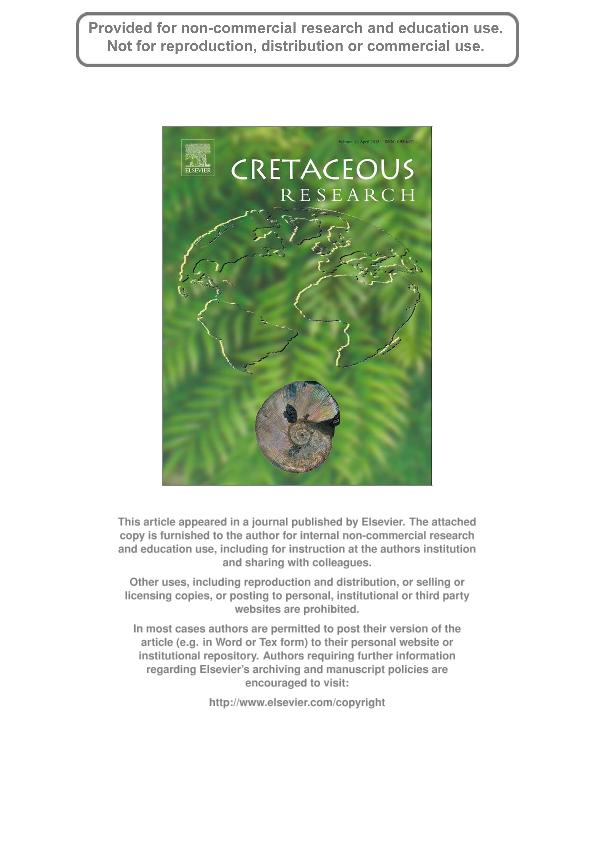Mostrar el registro sencillo del ítem
dc.contributor.author
Guler, Maria Veronica

dc.contributor.author
Lazo, Dario Gustavo

dc.contributor.author
Pazos, Pablo Jose

dc.contributor.author
Borel, Claudia Marcela

dc.contributor.author
Ottone, Eduardo Guillermo

dc.contributor.author
Tyson, R
dc.contributor.author
Cesaretti, Nora Noemi

dc.contributor.author
Aguirre-Urreta, Maria Beatriz

dc.date.available
2020-04-03T17:39:28Z
dc.date.issued
2013-03
dc.identifier.citation
Guler, Maria Veronica; Lazo, Dario Gustavo; Pazos, Pablo Jose; Borel, Claudia Marcela; Ottone, Eduardo Guillermo; et al.; Palynofacies analysis and palynology of the Agua de la Mula Member (Agrio Formation) in a sequence stratigraphy framework, Lower Cretaceous, Neuquén Basin, Argentina; Academic Press Ltd - Elsevier Science Ltd; Cretaceous Research; 41; 3-2013; 65-81
dc.identifier.issn
0195-6671
dc.identifier.uri
http://hdl.handle.net/11336/101876
dc.description.abstract
Variations in the sedimentary organic matter were documented throughout the Agua de la Mula Member (late Hauterivian) of the Agrio Formation, at a combined section in the type area of the Agrio Formation;the base at Agrio del Medio and the middle to top at Bajada del Agrio. A main organic-rich interval wasidentified in the basal Agua de la Mula Member, dominated by marine-derived Amorphous Organic Matter (AOM), coinciding with the highest Total Organic Carbon (TOC) content, between 1.4 and 3.8 wt.%,suggesting dysoxic conditions. The rest of the Member is predominantly characterized by terrestriallyderived organic matter, mainly phytoclasts, with low TOC values, around 1% or lower, indicating predominantly oxic depositional settings. By integrating stacking pattern and shell beds analysis, four depositional sequences SQ1eSQ4 were recognized. The organic-rich, finely laminated bituminous black shales of the Spitidiscus riccardii zone constitute a mayor and rapid inundation defining a Transgressive System tract (TST), related to a third order asymmetrical mesosequence dominated by a thick High System Tract (HST). It represents the most widespread and important flooding episode within the Neuquén Basin during the late Hauterivian. Inside sequences of higher frequency (SQ1, SQ2, SQ3, SQ4) of probably fourth order were recognized and analysed including several ammonids zones (Spitidiscus riccardii, Crioceratites schlagintweiti, C. diamantensis and Paraspiticeras groeberi). With the exception of the oxygen-controlled, basinal and outer ramp settings indicated for the TST1, which is equivalent to the TST of a lower order sequence, and the lower TST2, respectively, the prevalence of well oxygenated, inner to middle ramp depositional environments, is suggested for the rest of the sedimentary succession and emphasized in HST of SQ2, SQ3 and SQ4. Thus, a shallowing-upward trend with improved oxygenation is recorded through the Agua de la Mula Member, reflected by decreasing TOC, AOM content and preservation state of the organic matter. Based on the whole rock fluorescence analysis of the two selected organic-rich intervals from the Spitidiscus riccardii and the lowermost Crioceratites diamantensis zones,the presence of hydrocarbons suggests a very early in situ generation.
dc.format
application/pdf
dc.language.iso
eng
dc.publisher
Academic Press Ltd - Elsevier Science Ltd

dc.rights
info:eu-repo/semantics/openAccess
dc.rights.uri
https://creativecommons.org/licenses/by-nc-sa/2.5/ar/
dc.subject
PALYNOFACIES
dc.subject
AGRIO FORMATION
dc.subject
NEUQUEN BASIN
dc.subject
ARGENTINA
dc.subject.classification
Geociencias multidisciplinaria

dc.subject.classification
Ciencias de la Tierra y relacionadas con el Medio Ambiente

dc.subject.classification
CIENCIAS NATURALES Y EXACTAS

dc.title
Palynofacies analysis and palynology of the Agua de la Mula Member (Agrio Formation) in a sequence stratigraphy framework, Lower Cretaceous, Neuquén Basin, Argentina
dc.type
info:eu-repo/semantics/article
dc.type
info:ar-repo/semantics/artículo
dc.type
info:eu-repo/semantics/publishedVersion
dc.date.updated
2020-04-02T15:10:01Z
dc.journal.volume
41
dc.journal.pagination
65-81
dc.journal.pais
Países Bajos

dc.journal.ciudad
Amsterdam
dc.description.fil
Fil: Guler, Maria Veronica. Consejo Nacional de Investigaciones Científicas y Técnicas. Centro Científico Tecnológico Conicet - Bahía Blanca. Instituto Geológico del Sur. Universidad Nacional del Sur. Departamento de Geología. Instituto Geológico del Sur; Argentina
dc.description.fil
Fil: Lazo, Dario Gustavo. Consejo Nacional de Investigaciones Científicas y Técnicas. Oficina de Coordinación Administrativa Ciudad Universitaria. Instituto de Estudios Andinos "Don Pablo Groeber". Universidad de Buenos Aires. Facultad de Ciencias Exactas y Naturales. Instituto de Estudios Andinos "Don Pablo Groeber"; Argentina
dc.description.fil
Fil: Pazos, Pablo Jose. Consejo Nacional de Investigaciones Científicas y Técnicas. Oficina de Coordinación Administrativa Ciudad Universitaria. Instituto de Estudios Andinos "Don Pablo Groeber". Universidad de Buenos Aires. Facultad de Ciencias Exactas y Naturales. Instituto de Estudios Andinos "Don Pablo Groeber"; Argentina
dc.description.fil
Fil: Borel, Claudia Marcela. Consejo Nacional de Investigaciones Científicas y Técnicas. Centro Científico Tecnológico Conicet - Bahía Blanca. Instituto Geológico del Sur. Universidad Nacional del Sur. Departamento de Geología. Instituto Geológico del Sur; Argentina
dc.description.fil
Fil: Ottone, Eduardo Guillermo. Consejo Nacional de Investigaciones Científicas y Técnicas. Oficina de Coordinación Administrativa Ciudad Universitaria. Instituto de Estudios Andinos "Don Pablo Groeber". Universidad de Buenos Aires. Facultad de Ciencias Exactas y Naturales. Instituto de Estudios Andinos "Don Pablo Groeber"; Argentina
dc.description.fil
Fil: Tyson, R. Getech; Reino Unido
dc.description.fil
Fil: Cesaretti, Nora Noemi. Consejo Nacional de Investigaciones Científicas y Técnicas. Centro Científico Tecnológico Conicet - Bahía Blanca. Instituto Geológico del Sur. Universidad Nacional del Sur. Departamento de Geología. Instituto Geológico del Sur; Argentina
dc.description.fil
Fil: Aguirre-Urreta, Maria Beatriz. Consejo Nacional de Investigaciones Científicas y Técnicas. Oficina de Coordinación Administrativa Ciudad Universitaria. Instituto de Estudios Andinos "Don Pablo Groeber". Universidad de Buenos Aires. Facultad de Ciencias Exactas y Naturales. Instituto de Estudios Andinos "Don Pablo Groeber"; Argentina
dc.journal.title
Cretaceous Research

dc.relation.alternativeid
info:eu-repo/semantics/altIdentifier/doi/http://dx.doi.org/10.1016/j.cretres.2012.10.006
dc.relation.alternativeid
info:eu-repo/semantics/altIdentifier/url/https://www.sciencedirect.com/science/article/pii/S0195667112001589
Archivos asociados
